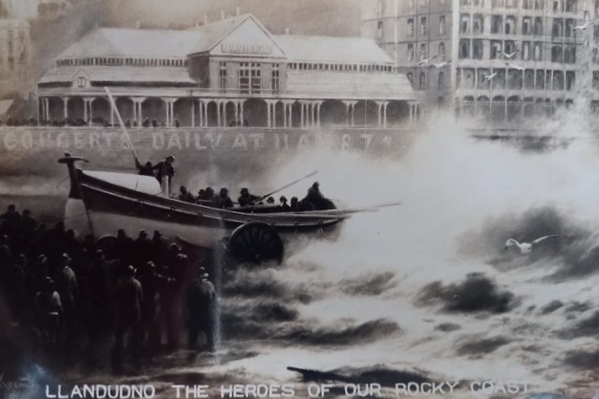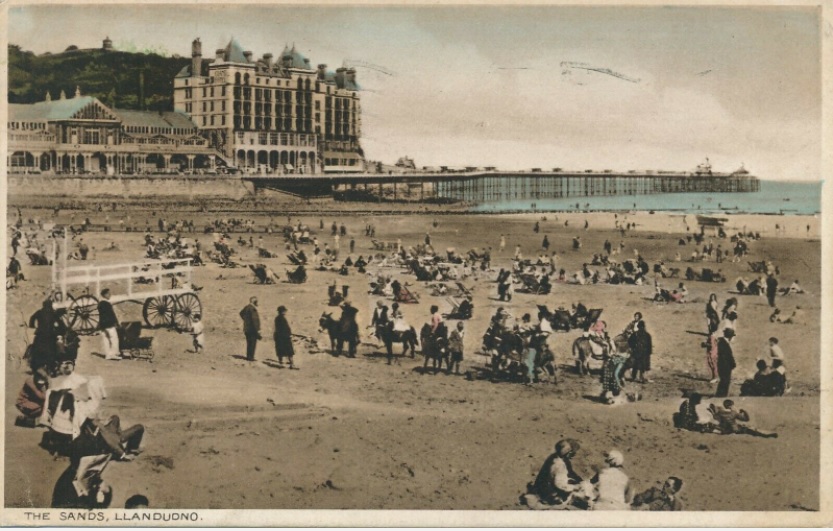Editor’s Staff
The Llandudno Heroes of the Sea
in part by Jane Matthews
Llandudno is a Welsh town with an ancient heritage. Along with many nearby villages such as Gogarth, Penrhyn Bay, Craigside, Glanwydden, Penrhynside, and Bryn Pydew there is a combined population of just over 20,000 citizens. Postcard History Online Magazine’s contributor Jane Matthews is one of them.


As I live by the coast, it seems an appropriate choice to write about a card celebrating the lifeboat crews who have risked their lives to rescue those in difficulty on the sea. Only a few nights ago there was a rescue going on further up the coast, with a lifeboat and a helicopter involved.
This card from 1907 shows a dramatic picture of a lifeboat being launched into heavy waves, surrounded by what looks like men in sou’westers. The crew are about to row out to sea, which would seem impossible in such a swell. The wheel, which can be seen at the side of the lifeboat, belongs to the horse drawn trailer which was used to pull the lifeboat to the beach.
The first Llandudno lifeboat was a rowing boat funded in 1861 by two Liverpool ladies in memory of their sister, who died the previous year. It was named “Sister’s Memorial.”
The coxswain was a copper miner who was alerted to any emergency by his daughter banging on a pipe at the top of the mineshaft. The lifeboat station was located by the railway depot in the town center, so the boat had to be taken on a horse drawn trailer to be launched on either the north or the west shore. The location of the station was intended to enable the boat to be taken by rail to nearby shores, but that never happened.
There were accidents during transportation. Two men lost their lives in the 1890s when they fell under the wheels of the carriage.
Stationed in Llandudno from 1902 to 1930, the boat we see on the postcard appears to be the self-righting lifeboat “Theodore Price.” It was pulled through the town and across the sand by 50 men, who presumably are those standing by. The use of horses to pull the boat was discontinued after 1899. It was too difficult to have them ready quickly and the cost was too high.
In 1903 a boathouse was built on Lloyd Street to enabled easy access to both shores, but the lifeboat still had to be towed through the town. This was the case until 2017 when a splendid new lifeboat station opened on the north shore. The current main lifeboat is a Shannon-class called the “William F. Yates,” after a donor to the Royal National Lifeboat Institution (RNLI), who had great affection for Llandudno.
The first motorized lifeboat was purchased in 1933, together with a tractor and new carriage for transportation through the streets. As there is no natural harbor, it was launched from a very sophisticated tractor unit and mobile slipway known as the Shannon Launch and Recovery System. There was also a small inshore lifeboat and the crews of both boats were volunteers.
Receiving no government funding, the RNLI is a charity which relies on donations to support its 349 lifeboats around the United Kingdom.
* * *
There is a small signature (Elmer Keene) on the bottom left of the picture. Ezra Elmer Keene (1853-1929) was a miller and baker, but later became a photographer and painter. Many of his coastal and rural images were used on postcards and his romantic moonlighted landscapes were very evocative.
* * *
The card’s message is written upside down and posted in Llandudno on July 15, 1907, it reads:
Dear Mr. Gooby,
Thanks for letter received. Sorry not to have answered before but have been so busy.
Pleased to hear you had a good time at the J. O. M. I suppose you have quite settled
down to work again. Kind regards, M. Breeze.
At first it seemed to be a message from a holidaymaker to someone back at work in London, but it would be odd to have given the excuse of being too busy if on holiday. I therefore started to think that Mr. Gooby had been to Llandudno on holiday and this was a card from someone he met there and had later written to about his good time.
A thorough search of the records discloses that Mr. Gooby was indeed Albert William Gooby of Packington Road in the Acton neighborhood of London. Albert worked as a railroad clerk and from 1916 served with the Royal Engineers as part of the British Expeditionary Force sent to France. In his later years he married and returned to the railroad to work. He died in 1977 at age 95.
* * *
There are a great number of postcards showing holiday and resort locations in the United Kingdom. Llandudno is but one of them. It has been a number of years since the last visit I made to Wales when I discovered that my fifth great-grandfather left there for Pennsylvania, and it is difficult to remember all the conversations, nevertheless one bit of trivia comes to mind. The word “beach” is seldom heard.

In England a beach is often called a Seaside. And, in Wales a beach is referred to as the Sands.
Even in the early 2000s the beaches in Wales were must the same as the image on this card, which was mailed to London in August 1923. Do look closely: of the many visitors there are very few in the water. Most everyone is fully dressed and there are no beach-blankets or umbrellas. There are some youngsters enjoying donkey-rides, but little else, except for conversation and the random picnic is happening.
I wonder if J.O.M. should have read I.O.M., and referred to Isle of Man (an island off the West Coast of Britain and mainly a tourist destination)?
Perhaps we could have an article on Scotland now we have had Wales! Please
My mother is Welsh. Her family emigrated in the nineteenth century to work in the coal mines in Colchester, IL. I visited an abandoned monastery in l984. It was one of the ones King Henry VIII took over as part of his campaign to stamp-out Roman Catholicism. I enjoyed this article about life-saving.
In Baltimore, people headed for the beach say they’re going “down the shore”.